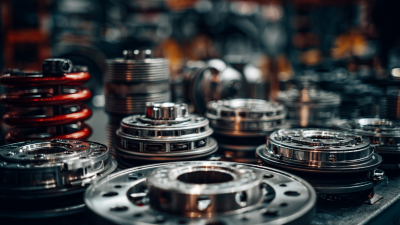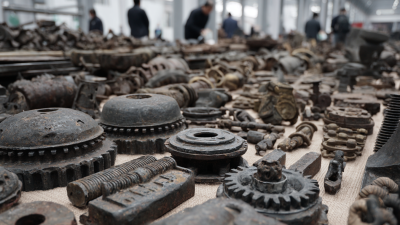Blog
Finding the Right Parts for My Car to Ensure Optimal Performance and Safety
 When it comes to maintaining optimal performance and safety for your vehicle, the right parts for my car play a crucial role. According to a report by the Automotive Aftermarket Industry Association, the automotive parts market is expected to reach $458.5 billion by 2024, reflecting the increasing importance of high-quality components in enhancing vehicle reliability and efficiency. As vehicles become more complex with advancements in technology, choosing the correct parts not only ensures safety standards are met but also improves overall driving experience. With the growing trend of DIY maintenance among car owners, understanding how to source and select the best parts for my car has never been more essential. This guide aims to equip you with the knowledge to navigate the vast selection of automotive parts, ensuring your vehicle remains in peak condition for every journey.
When it comes to maintaining optimal performance and safety for your vehicle, the right parts for my car play a crucial role. According to a report by the Automotive Aftermarket Industry Association, the automotive parts market is expected to reach $458.5 billion by 2024, reflecting the increasing importance of high-quality components in enhancing vehicle reliability and efficiency. As vehicles become more complex with advancements in technology, choosing the correct parts not only ensures safety standards are met but also improves overall driving experience. With the growing trend of DIY maintenance among car owners, understanding how to source and select the best parts for my car has never been more essential. This guide aims to equip you with the knowledge to navigate the vast selection of automotive parts, ensuring your vehicle remains in peak condition for every journey.
Identifying Essential Parts for Your Vehicle's Performance and Safety
When it comes to ensuring your vehicle's performance and safety, identifying essential parts is crucial. According to the National Highway Traffic Safety Administration (NHTSA), over 22% of vehicle crashes are attributed to maintenance-related issues, highlighting the importance of proper vehicle upkeep. Critical components such as brake systems, tires, and steering mechanisms directly influence both performance and safety. Regular inspections and timely replacements of these parts not only improve driving dynamics but also significantly reduce the risk of accidents.
Furthermore, a recent study by the Automotive Aftermarket Industry Association (AAIA) indicates that replacing worn-out parts can enhance fuel efficiency by up to 15%. Key parts like air filters, spark plugs, and battery systems continuously affect engine performance. Ensuring that these components are in optimal condition not only contributes to a smoother driving experience but also supports environmental sustainability by reducing emissions. Therefore, regular assessments and replacements of both major and minor parts are essential for maintaining the overall health of your vehicle.

Understanding OEM vs. Aftermarket Parts: What's Best for Your Car?
When choosing car parts, the debate between OEM (Original Equipment Manufacturer) and aftermarket parts becomes crucial for both performance and safety.
OEM parts are specifically made for your vehicle by the manufacturer, ensuring compatibility and reliability. In contrast, aftermarket parts are produced by third-party companies and can vary in quality and fit. According to a recent industry analysis, using OEM parts can improve vehicle longevity by up to 15%, while high-quality aftermarket parts might provide a budget-friendly alternative without compromising safety.
However, current events such as tariffs on imported auto parts are affecting consumer choices. A 25% tariff on imported vehicles and parts could considerably drive up prices, leading many drivers to consider cheaper aftermarket options. It's essential to weigh the potential cost savings against quality and safety.
Tips: Always research and verify the reputation of aftermarket brands to ensure their products meet safety regulations. Additionally, consult with your mechanic regarding the best option for your specific vehicle model. Investing in OEM parts might be pricier upfront, but it often translates into fewer repairs down the line.
Conducting a Thorough Inspection to Determine Parts Needs
When it comes to ensuring optimal performance and safety for your vehicle, conducting a thorough inspection is crucial. The first step is to check the essential components of your car, including the brakes, tires, fluids, and lights. For example, worn brake pads can significantly affect stopping power, while low tire tread can lead to poor traction. A detailed inspection allows you to identify these issues early, preventing more significant problems down the road.
In addition to physical inspections, utilizing diagnostic tools can provide deeper insights into your car's condition. Modern vehicles are equipped with onboard diagnostics that can reveal issues not immediately visible. By reading error codes, you can pinpoint specific parts that need attention, from the battery to the engine sensors. Moreover, keeping a maintenance log will help you track the condition of various parts over time, allowing you to make informed decisions about which replacements are necessary to maintain both performance and safety.
Parts Inspection Data for Optimal Car Performance and Safety
The following bar chart represents the inspection findings of various parts of a car to ensure optimal performance and safety. Each category shows the percentage of parts that require immediate attention during the inspection.
Tips for Sourcing Reliable and Quality Auto Parts Online
When sourcing reliable and quality auto parts online, it’s essential to start by identifying trustworthy suppliers. Look for established retailers with positive customer reviews and a reputation for delivering quality products. Websites that specialize in auto parts often provide detailed specifications, compatibility information, and return policies, which can help you make informed decisions. Don’t hesitate to check out forums or community discussions centered around your specific car model to gather insights on recommended suppliers and products.
Another crucial step is to evaluate the parts you are considering. Prioritize OEM (Original Equipment Manufacturer) parts for optimal fit and performance, as these are often built to the same standards as the original components. When opting for aftermarket parts, ensure they come with certifications and warranties to guarantee their reliability. Additionally, pay attention to the return policies; a flexible return policy can provide peace of mind, allowing you to exchange or return parts that may not meet your expectations or compatibility requirements. By following these guidelines, you can enhance your vehicle's performance and safety with quality parts sourced online.

Maintaining and Replacing Parts: Best Practices for Longevity
Maintaining and replacing parts in your vehicle is essential for ensuring its longevity and optimal performance. Regular inspections and maintenance checks can help identify wear and tear before they lead to serious issues. It is advisable to follow the manufacturer's recommendations for maintenance schedules, which typically include changing oil, replacing air filters, and checking brake pads. By adhering to these guidelines, you can enhance the safety of your vehicle while also improving its efficiency.
When it comes to replacing parts, quality should always be prioritized. Choosing OEM (Original Equipment Manufacturer) parts may cost more upfront, but they often provide better reliability and compatibility with your car. Additionally, consider the environmental impact of your choices; opting for refurbished or sustainably sourced parts can contribute to a more eco-friendly approach to vehicle maintenance. Regularly cleaning and taking care of components like the battery, tires, and suspension can also prolong their life, reducing the need for frequent replacements. By implementing these best practices, you can ensure that your vehicle performs at its best while keeping safety at the forefront.
Finding the Right Parts for My Car to Ensure Optimal Performance and Safety - Maintaining and Replacing Parts: Best Practices for Longevity
| Part Type | Recommended Replacement Interval (miles) | Signs of Wear | Best Practice for Maintenance |
|---|---|---|---|
| Oil Filter | 5,000 - 7,500 | Oil leaks, poor engine performance | Change with every oil change |
| Brake Pads | 30,000 - 70,000 | Squeaking, grinding noise | Inspect regularly, replace as needed |
| Air Filter | 15,000 - 30,000 | Reduced engine power, poor fuel economy | Check during oil changes |
| Tires | 40,000 - 60,000 | Uneven wear, low tread depth | Rotate regularly, check pressure |
| Battery | 3 - 5 years | Slow engine crank, corrosion | Test annually, clean terminals |
Related Posts
-

Unlocking Sustainability: How Car Recycling Parts Contribute to a Greener Future
-

The Ultimate Guide to Choosing Quality Car Auto Parts for Your Vehicle's Long Life
-

The Future of Eco Cars Exploring Sustainable Innovations for a Greener Planet
-

Exploring Junk Parts Innovations at the 2025 China 138th Canton Fair
-

Why Automotive Body Parts Are Crucial for Vehicle Safety: Understanding the Industry Standards and Impact
-

Understanding the Essential Role of Auto Parts in Vehicle Performance and Safety
Logel’s Auto Parts
116 Bridge St East
Kitchener, Ontario
N2K 1J6
Phone: 519-745-4751
Toll Free: 1-800-818-9118
Hours 8:00-5:00 Monday to Friday
At Logel’s Auto Parts, we serve a range of communities in Southern Ontario, including:



